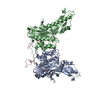+ Open data
Open data
- Basic information
Basic information
| Entry | Database: PDB / ID: 8bah | |||||||||||||||
|---|---|---|---|---|---|---|---|---|---|---|---|---|---|---|---|---|
| Title | Human Mre11-Nbs1 complex | |||||||||||||||
 Components Components |
| |||||||||||||||
 Keywords Keywords | HYDROLASE / DNA repair / complex | |||||||||||||||
| Function / homology |  Function and homology information Function and homology informationtelomere maintenance via telomere trimming / chromosomal region / telomeric 3' overhang formation / mitochondrial double-strand break repair via homologous recombination / Mre11 complex / negative regulation of double-strand break repair via nonhomologous end joining / blastocyst growth / negative regulation of telomere capping / BRCA1-C complex / Sensing of DNA Double Strand Breaks ...telomere maintenance via telomere trimming / chromosomal region / telomeric 3' overhang formation / mitochondrial double-strand break repair via homologous recombination / Mre11 complex / negative regulation of double-strand break repair via nonhomologous end joining / blastocyst growth / negative regulation of telomere capping / BRCA1-C complex / Sensing of DNA Double Strand Breaks / meiotic DNA double-strand break formation / protection from non-homologous end joining at telomere / regulation of mitotic recombination / R-loop processing / t-circle formation / single-stranded DNA endodeoxyribonuclease activity / phosphorylation-dependent protein binding / homologous chromosome pairing at meiosis / DNA strand resection involved in replication fork processing / homologous recombination / nuclease activity / nuclear inclusion body / 3'-5'-DNA exonuclease activity / DNA double-strand break processing / Impaired BRCA2 binding to PALB2 / double-strand break repair via alternative nonhomologous end joining / isotype switching / chromatin-protein adaptor activity / Cytosolic sensors of pathogen-associated DNA / protein localization to site of double-strand break / mitotic G2/M transition checkpoint / HDR through MMEJ (alt-NHEJ) / IRF3-mediated induction of type I IFN / reciprocal meiotic recombination / mitotic intra-S DNA damage checkpoint signaling / regulation of DNA-templated DNA replication initiation / Homologous DNA Pairing and Strand Exchange / Defective homologous recombination repair (HRR) due to BRCA1 loss of function / Defective HDR through Homologous Recombination Repair (HRR) due to PALB2 loss of BRCA1 binding function / Defective HDR through Homologous Recombination Repair (HRR) due to PALB2 loss of BRCA2/RAD51/RAD51C binding function / Resolution of D-loop Structures through Synthesis-Dependent Strand Annealing (SDSA) / sister chromatid cohesion / Resolution of D-loop Structures through Holliday Junction Intermediates / HDR through Single Strand Annealing (SSA) / neuromuscular process controlling balance / positive regulation of double-strand break repair / Impaired BRCA2 binding to RAD51 / mitotic G2 DNA damage checkpoint signaling / positive regulation of telomere maintenance / telomere maintenance in response to DNA damage / Presynaptic phase of homologous DNA pairing and strand exchange / protein K63-linked ubiquitination / neuroblast proliferation / telomere maintenance via telomerase / positive regulation of double-strand break repair via homologous recombination / 3'-5' exonuclease activity / telomere maintenance / intrinsic apoptotic signaling pathway / DNA damage checkpoint signaling / protein serine/threonine kinase activator activity / replication fork / DNA endonuclease activity / meiotic cell cycle / DNA damage response, signal transduction by p53 class mediator / Nonhomologous End-Joining (NHEJ) / double-strand break repair via homologous recombination / PML body / G2/M DNA damage checkpoint / HDR through Homologous Recombination (HRR) / double-strand break repair via nonhomologous end joining / DNA Damage/Telomere Stress Induced Senescence / Meiotic recombination / double-strand break repair / manganese ion binding / Recruitment and ATM-mediated phosphorylation of repair and signaling proteins at DNA double strand breaks / site of double-strand break / Processing of DNA double-strand break ends / double-stranded DNA binding / DNA recombination / histone binding / Regulation of TP53 Activity through Phosphorylation / DNA-binding transcription factor binding / damaged DNA binding / Hydrolases; Acting on ester bonds / chromosome, telomeric region / cell population proliferation / regulation of cell cycle / cadherin binding / DNA repair / DNA damage response / negative regulation of apoptotic process / nucleolus / Golgi apparatus / nucleoplasm / identical protein binding / nucleus / cytoplasm / cytosol Similarity search - Function | |||||||||||||||
| Biological species |  Homo sapiens (human) Homo sapiens (human) | |||||||||||||||
| Method | ELECTRON MICROSCOPY / single particle reconstruction / cryo EM / Resolution: 4.13 Å | |||||||||||||||
 Authors Authors | Bartho, J.D. / Rotheneder, M. / Stakyte, K. / Lammens, K. / Hopfner, K.P. | |||||||||||||||
| Funding support |  Germany, 4items Germany, 4items
| |||||||||||||||
 Citation Citation |  Journal: Mol Cell / Year: 2023 Journal: Mol Cell / Year: 2023Title: Cryo-EM structure of the Mre11-Rad50-Nbs1 complex reveals the molecular mechanism of scaffolding functions. Authors: Matthias Rotheneder / Kristina Stakyte / Erik van de Logt / Joseph D Bartho / Katja Lammens / Yilan Fan / Aaron Alt / Brigitte Kessler / Christophe Jung / Wynand P Roos / Barbara ...Authors: Matthias Rotheneder / Kristina Stakyte / Erik van de Logt / Joseph D Bartho / Katja Lammens / Yilan Fan / Aaron Alt / Brigitte Kessler / Christophe Jung / Wynand P Roos / Barbara Steigenberger / Karl-Peter Hopfner /  Abstract: The DNA double-strand break repair complex Mre11-Rad50-Nbs1 (MRN) detects and nucleolytically processes DNA ends, activates the ATM kinase, and tethers DNA at break sites. How MRN can act both as ...The DNA double-strand break repair complex Mre11-Rad50-Nbs1 (MRN) detects and nucleolytically processes DNA ends, activates the ATM kinase, and tethers DNA at break sites. How MRN can act both as nuclease and scaffold protein is not well understood. The cryo-EM structure of MRN from Chaetomium thermophilum reveals a 2:2:1 complex with a single Nbs1 wrapping around the autoinhibited Mre11 nuclease dimer. MRN has two DNA-binding modes, one ATP-dependent mode for loading onto DNA ends and one ATP-independent mode through Mre11's C terminus, suggesting how it may interact with DSBs and intact DNA. MRNs two 60-nm-long coiled-coil domains form a linear rod structure, the apex of which is assembled by the two joined zinc-hook motifs. Apices from two MRN complexes can further dimerize, forming 120-nm spanning MRN-MRN structures. Our results illustrate the architecture of MRN and suggest how it mechanistically integrates catalytic and tethering functions. | |||||||||||||||
| History |
|
- Structure visualization
Structure visualization
| Structure viewer | Molecule:  Molmil Molmil Jmol/JSmol Jmol/JSmol |
|---|
- Downloads & links
Downloads & links
- Download
Download
| PDBx/mmCIF format |  8bah.cif.gz 8bah.cif.gz | 316.3 KB | Display |  PDBx/mmCIF format PDBx/mmCIF format |
|---|---|---|---|---|
| PDB format |  pdb8bah.ent.gz pdb8bah.ent.gz | 244 KB | Display |  PDB format PDB format |
| PDBx/mmJSON format |  8bah.json.gz 8bah.json.gz | Tree view |  PDBx/mmJSON format PDBx/mmJSON format | |
| Others |  Other downloads Other downloads |
-Validation report
| Summary document |  8bah_validation.pdf.gz 8bah_validation.pdf.gz | 1.1 MB | Display |  wwPDB validaton report wwPDB validaton report |
|---|---|---|---|---|
| Full document |  8bah_full_validation.pdf.gz 8bah_full_validation.pdf.gz | 1.1 MB | Display | |
| Data in XML |  8bah_validation.xml.gz 8bah_validation.xml.gz | 34.4 KB | Display | |
| Data in CIF |  8bah_validation.cif.gz 8bah_validation.cif.gz | 50.3 KB | Display | |
| Arichive directory |  https://data.pdbj.org/pub/pdb/validation_reports/ba/8bah https://data.pdbj.org/pub/pdb/validation_reports/ba/8bah ftp://data.pdbj.org/pub/pdb/validation_reports/ba/8bah ftp://data.pdbj.org/pub/pdb/validation_reports/ba/8bah | HTTPS FTP |
-Related structure data
| Related structure data |  15948MC  7zqyC  7zr1C M: map data used to model this data C: citing same article ( |
|---|---|
| Similar structure data | Similarity search - Function & homology  F&H Search F&H Search |
- Links
Links
- Assembly
Assembly
| Deposited unit | 
|
|---|---|
| 1 |
|
- Components
Components
| #1: Protein | Mass: 84008.633 Da / Num. of mol.: 2 / Mutation: H129N Source method: isolated from a genetically manipulated source Source: (gene. exp.)  Homo sapiens (human) / Gene: MRE11, HNGS1, MRE11A / Plasmid: pACEMam1_pMDC / Cell line (production host): HEK293T / Production host: Homo sapiens (human) / Gene: MRE11, HNGS1, MRE11A / Plasmid: pACEMam1_pMDC / Cell line (production host): HEK293T / Production host:  Homo sapiens (human) Homo sapiens (human)References: UniProt: P49959, Hydrolases; Acting on ester bonds #2: Protein | | Mass: 85073.023 Da / Num. of mol.: 1 Source method: isolated from a genetically manipulated source Source: (gene. exp.)  Homo sapiens (human) / Gene: NBN, NBS, NBS1, P95 / Plasmid: pACEMam1_pMDC / Cell line (production host): HEK293T / Production host: Homo sapiens (human) / Gene: NBN, NBS, NBS1, P95 / Plasmid: pACEMam1_pMDC / Cell line (production host): HEK293T / Production host:  Homo sapiens (human) / References: UniProt: O60934 Homo sapiens (human) / References: UniProt: O60934#3: Chemical | ChemComp-MN / Has ligand of interest | Y | |
|---|
-Experimental details
-Experiment
| Experiment | Method: ELECTRON MICROSCOPY |
|---|---|
| EM experiment | Aggregation state: PARTICLE / 3D reconstruction method: single particle reconstruction |
- Sample preparation
Sample preparation
| Component | Name: Human Mre11-Nbs1 complex / Type: COMPLEX Details: Human Mre11-dimer with Nbs1 C-terminal chain bound. Entity ID: #1-#2 / Source: RECOMBINANT | |||||||||||||||||||||||||||||||||||||||||||||
|---|---|---|---|---|---|---|---|---|---|---|---|---|---|---|---|---|---|---|---|---|---|---|---|---|---|---|---|---|---|---|---|---|---|---|---|---|---|---|---|---|---|---|---|---|---|---|
| Molecular weight | Experimental value: NO | |||||||||||||||||||||||||||||||||||||||||||||
| Source (natural) | Organism:  Homo sapiens (human) Homo sapiens (human) | |||||||||||||||||||||||||||||||||||||||||||||
| Source (recombinant) | Organism:  Homo sapiens (human) / Cell: HEK293T / Plasmid: pACEMam1_pMDC Homo sapiens (human) / Cell: HEK293T / Plasmid: pACEMam1_pMDC | |||||||||||||||||||||||||||||||||||||||||||||
| Buffer solution | pH: 7 Details: 20 mM HEPES (pH 7.0), 140 mM NaCl, 5 mM MgCl2, 1 mM MnCl2, 0.020 mM ZnCl2, 0.2 mM TCEP, 2 mM ATPgS, plus 0.05 percent beta-OG | |||||||||||||||||||||||||||||||||||||||||||||
| Buffer component |
| |||||||||||||||||||||||||||||||||||||||||||||
| Specimen | Conc.: 0.29 mg/ml / Embedding applied: NO / Shadowing applied: NO / Staining applied: NO / Vitrification applied: YES | |||||||||||||||||||||||||||||||||||||||||||||
| Specimen support | Grid material: COPPER / Grid mesh size: 200 divisions/in. / Grid type: Quantifoil R2/1 | |||||||||||||||||||||||||||||||||||||||||||||
| Vitrification | Instrument: LEICA EM GP / Cryogen name: ETHANE / Humidity: 95 % / Chamber temperature: 288 K |
- Electron microscopy imaging
Electron microscopy imaging
| Experimental equipment |  Model: Titan Krios / Image courtesy: FEI Company |
|---|---|
| Microscopy | Model: FEI TITAN KRIOS |
| Electron gun | Electron source:  FIELD EMISSION GUN / Accelerating voltage: 300 kV / Illumination mode: FLOOD BEAM FIELD EMISSION GUN / Accelerating voltage: 300 kV / Illumination mode: FLOOD BEAM |
| Electron lens | Mode: BRIGHT FIELD / Nominal magnification: 13000 X / Nominal defocus max: 2800 nm / Nominal defocus min: 1000 nm / Cs: 2.7 mm / C2 aperture diameter: 50 µm |
| Specimen holder | Cryogen: NITROGEN / Specimen holder model: FEI TITAN KRIOS AUTOGRID HOLDER |
| Image recording | Average exposure time: 10 sec. / Electron dose: 43 e/Å2 / Detector mode: COUNTING / Film or detector model: GATAN K2 SUMMIT (4k x 4k) / Num. of grids imaged: 3 / Num. of real images: 11325 |
| EM imaging optics | Energyfilter name: GIF Bioquantum / Energyfilter slit width: 20 eV |
| Image scans | Movie frames/image: 40 |
- Processing
Processing
| Software | Name: PHENIX / Version: 1.20.1_4487: / Classification: refinement | ||||||||||||||||||||||||||||||||||||
|---|---|---|---|---|---|---|---|---|---|---|---|---|---|---|---|---|---|---|---|---|---|---|---|---|---|---|---|---|---|---|---|---|---|---|---|---|---|
| EM software |
| ||||||||||||||||||||||||||||||||||||
| CTF correction | Type: PHASE FLIPPING AND AMPLITUDE CORRECTION | ||||||||||||||||||||||||||||||||||||
| 3D reconstruction | Resolution: 4.13 Å / Resolution method: FSC 0.143 CUT-OFF / Num. of particles: 282838 / Symmetry type: POINT | ||||||||||||||||||||||||||||||||||||
| Refine LS restraints |
|
 Movie
Movie Controller
Controller









 PDBj
PDBj










